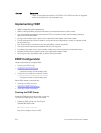RRoCE packets are received and transmitted on specific interfaces called lite-subinterfaces. These
interfaces are similar to the normal Layer 3 physical interfaces except for the extra provisioning that they
offer to enable the VLAN ID for encapsulation.
You can configure a physical interface or a Layer 3 Port Channel interface as a lite subinterface. When
you configure a lite subinterface, only tagged IP packets with VLAN encapsulation are processed and
routed. All other data packets are discarded.
A normal Layer 3 physical interface processes only untagged packets and makes routing decisions based
on the default Layer 3 VLAN ID (4095).
To enable routing of RRoCE packets, the VLAN ID is mapped to the default VLAN ID of 4095 using VLAN
translation. After the VLAN translation, the RRoCE packets are processed in the same way as normal IP
packets that a Layer 3 interface receives and routes in the egress direction. At the egress interface, the
VLAN ID is appended to the packet and transmitted out of the interface as a tagged packet with the
dot1Q value preserved.
To provide lossless service for RRoCE, the QoS service policy must be configured in the ingress and
egress directions on lite sub interfaces.
Preserving 802.1Q VLAN Tag Value for Lite Subinterfaces
This functionality is supported on the platform.
All the frames in a Layer 2 VLAN are identified using a tag defined in the IEEE 802.1Q standard to
determine the VLAN to which the frames or traffic are relevant or associated. Such frames are
encapsulated with the 802.1Q tags. If a single VLAN is configured in a network topology, all the traffic
packets contain the same do1q tag, which is the tag value of the 802.1Q header. If a VLAN is split into
multiple, different sub-VLANs, each VLAN is denoted by a unique 8021.Q tag to enable the nodes that
receive the traffic frames determine the VLAN for which the frames are destined.
Typically, a Layer 3 physical interface processes only untagged or priority-tagged packets. Tagged
packets that are received on Layer 3 physical interfaces are dropped. To enable the routing of tagged
packets, the port that receives such tagged packets needs to be configured as a switchport and must be
bound to a VLAN as a tagged member port.
A lite subinterface is similar to a normal Layer 3 physical interface, except that additional provisioning is
performed to set the VLAN ID for encapsulation.
A physical interface or a Layer 3 Port channel interface can be configured as a lite subinterface. Once a
lite subinterface is configured, only tagged IP packets with encapsulation VLAN ID are processed and
routed. All other data packets are discarded except the Layer 2 and Layer 3 control frames. It is not
required for a VLAN ID to be preserved (in the hardware or the OS application) when a VLAN ID, used for
encapsulation, is associated with a physical/Port-channel interface. Normal VLANs and VLAN
encapsulation can exist simultaneously and any non-unicast traffic received on a normal VLAN is not
flooded using lite subinterfaces whose encapsulation VLAN ID matches with that of the normal VLAN ID.
You can use the encapsulation dot1q vlan-id command in INTERFACE mode to configure lite
subinterfaces.
Flex Hash
367


















